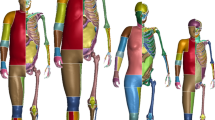Abstract
Pedestrian protection has become an increasingly important consideration in vehicle crash safety. Pedestrian-vehicle crashes cause a significant number of pedestrian fatalities and injuries globally. Computer models are powerful tools for understanding how to reduce the severity of injuries in such crashes. Real-world studies of pedestrians provide an important source of information for evaluating pedestrian model dynamic performance and ability to reconstruct injury-causing events. This study describes the validation process of deformable pedestrian model using published postmortem human subject (PMHS) trajectory and head resultant velocity corridors, and demonstrates its applicability to pedestrian — vehicle impact research. We implemented the deformable pedestrian model using LS-DYNA finite element code. Based on PMHS data, the pedestrian model is used to validate the displacement trajectories of the head, pelvis, knee and foot. The finite element pedestrian model thus obtained can help assess the friendliness of vehicles with pedestrians in traffic crashes and assist in the future development of pedestrian safety technologies.
Similar content being viewed by others
References
A. Linder, C. Douglas, A. Clark, B. Fildes, J. Yang and D. Otte, Mathematical simulation of real-world pedestrian-vehicle collisions, The 19th International Technical Conference on the Enhanced Safety of Vehicles (ESV), Washington D.C, USA. (2006) Paper No. 05-285.
NHTSA’s (National Highway Traffic Safety Administration) Annual Assessment of Motor Vehicle Crash: Motor Vehicle Traffic Crash Fatality Counts and Estimates People of Injured for 2005 — Updated December 13, 2006.
SUSPA Gaspedern: http://www.suspa.com.
R. Fredriksson, Y. Håland and J. Yang, Evaluation of a new pedestrian head injury protection system with a sensor in the bumper and lifting of the bonnet’s rear part, The 17th International Technical Conference on the Enhanced Safety of Vehicles (ESV), Amsterdam, Netherlands. (2001) Paper number: 131.
M. Paine, Pedestrian protection by vehicle design, unofficial report on an international seminar, Adelaide, Australia. (1999) Copy at: http://www1.tpgi.com.au/users/mpaine/ppvd.html.
Find Articles: Ward’s Auto World Pedestrian Impact.htm.
The Insurance Institute for Highway Safety-The Highway Loss Data Institute (Q&A: PEDESTRIANS): http://www.iihs.org/default.html.
M. Neal, H. S. Kim, J. T. Wang, T. Fujimura and K. Nagai, Development of LS-DYNA finite element models for simulating EEVC pedestrian impact, The 18th International Technical Conference on the Enhanced Safety of Vehicles (ESV), Nagoya, Japan. (2003) Paper Number 335.
A. Konosu, H. Ishikawa and R. Kant, Development of computer simulation models for pedestrian subsystem impact tests, JSAE Review. 21 (2000) 109–115.
A. Long and R. Anderson, The development and validation of the IHRA pedestrian model using MADYMO and AutoDOE, Proceedings of the 2005 MADYMO Users Meeting. Australia (2005).
A. Konosu, Reconstruction analysis for car-pedestrian accidents using a computer simulation model, JSAE Review. 23 (2002) 357–363.
M. Iwamoto, K. Omori, H. Kimpara, Y. Nakahira, A. Tamura, I. Watanabe, K. Miki, J. Hasegawa and F. Oshita, Recent advanes in THUMS: Development of Individual Internal Organs, Brain, Small Female, and Pedestrian Model, 4 th European LS-DYNA Users Conference, Ulm, Germany. (2003).
J. Stammen and A. Barsan-Anelli, Adaptation of a Human Body Mathematical Model to Simulation of Pedestrian/Vehicle Interaction, 4th MADYMO User’s Meeting of the America’s, Detroit, Michigan, USA. (2001).
L. van Rooij, M. Meissner, K. Bhalla, J. Crandall, D. Longhitano, Y. Takahashi, Y. Dokko and Y. Kikuchi, The evaluation of the kinematics of the MADYMO human pedestrian model against experimental tests and the influence of a more biofidelic knee joint, TNO MADYMO 5th Users’ Meeting of the Americas, Troy, Michigan, USA. (2003).
Author information
Authors and Affiliations
Corresponding author
Additional information
This paper was recommended for publication in revised form by Associate Editor Young Eun Kim
Tso-Liang Teng is a Professo r in the Department of mechanical and automation engi-neer ing and the Dean of engineeri ng college at the Da-Yeh Uni versity, Taiwan. He received a BS (1981), MS (1986) and PhD (1994) from the Chung Cheng Institute of Technology. His research intere sts include design of passive safety systems in ve hicles, crash tests simulation, passenger and pedest rian injuries analysis, design of pedestrian protecti on systems.
Rights and permissions
About this article
Cite this article
Teng, TL., Le, TK. Development and validation of a pedestrian deformable finite element model. J Mech Sci Technol 23, 2268–2276 (2009). https://doi.org/10.1007/s12206-009-0520-3
Received:
Revised:
Accepted:
Published:
Issue Date:
DOI: https://doi.org/10.1007/s12206-009-0520-3




